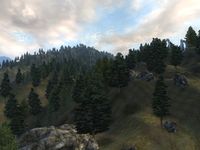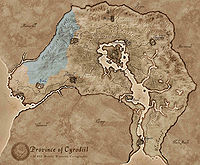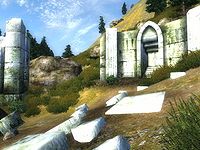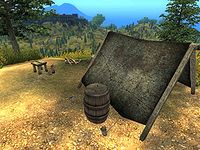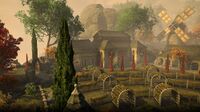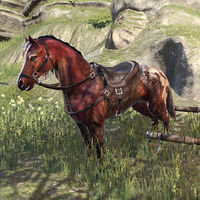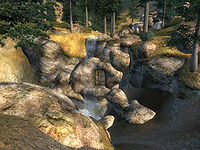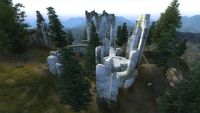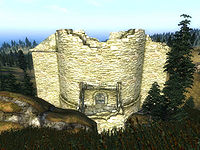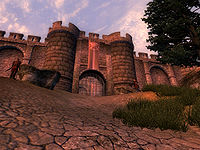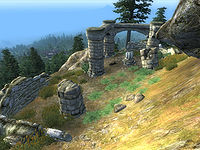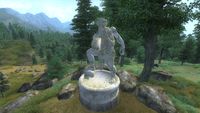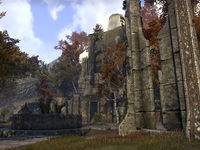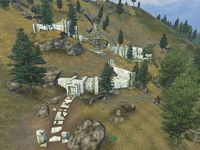User:Vincentius1/Sandbox 3
Introduction[edit]
| Colovian Highlands | |
|---|---|
| Type | Region |
| Continent | Tamriel |
| Province | Cyrodiil |
| Subregions | Battlehorn Imperial Reserve Strid Vale |
| Demonym(s) | Highlander[1] |
| Appears in | Oblivion, ESO |
The Colovian Highlands (also called the Colovian Hills)[2][3] are a hilly, forested region on the northwestern outskirts of Colovia, in the province of Cyrodiil. The Highlands are a remote region, far off from the centers of civilization in the Imperial Province.[4][5] It runs along the border with Hammerfell to the west, between the eastern Brena River, the western Imperial Reserve, and the northern County Chorrol.[6]
The major cities of Chorrol and Kvatch sit on the edge of their respective regions before they lead into the Colovian Highlands. The region is geographically bordered by the Great Forest to the east, the Gold Coast to the west, the Jerall Mountains to the northeast, and the West Weald to the south.[6] Across the provincial border, it neighbors the general eastern Hammerfell region, near the cities Elinhir and Rihad.[7]
Society and Geography[edit]
Demographics[edit]
Unlike other parts of Cyrodiil, like the Heartlands or even Colovia's county seats, the Colovian Highlands is remote, the furthest from civilization.[4] By the late Third Era, no one lived in the region,[5] but as late as the Interregnum, settlements have existed to some capacity.[8] The Highlands' main demographic is historically the Colovians, the western Imperials of Cyrodiil, but here, they distinguished themselves as Highlanders.[1] One of the region's main settlements were Ontus and Leftwheal,[9] and though it falls more in the Great Forest, County Chorrol and its capital city overlap with the region.[1][10]
In the Interregnum, most of Colovia, between Varen's Wall and central Cyrodiil were considered part of the West Weald, with Skingrad as its capital. Parts of the Gold Coast that did not fall into Varen's Wall (i.e., Sutch and Niryastare) ostensibly became part of the Colovian Highlands and marked the Highlands Road.[8][9][2] Some notable figures and families are from the Colovian Highlands include the Imperial scholar, Dubicius,[11] and House Valente, who were well-known winemakers.[12] Somewhere west of Skingrad, near the Weatherleah Estate was Villa Doria, the old estate of Emperor Brazollus Dor.[13]
Because the Highlands fall right on the border with Hammerfell, many Redguards settled here and provided a taste of Hammerfell's lifestyle. It was especially seen in Leftwheal as the overland route with Rihad had active use in the mid-Second Era.[9] As recent as the late Third Era, the Knights of the True Horn from Lainlyn briefly lived in the northernmost Highlands.[14] Many Ayleid ruins litter the region. Their histories are mostly unknown, except they were part of the Ayleid Empire. Some of their main settlements include Talwinque and Varondo, whose clans largely survived the Ayleid Diaspora and settled in Valenwood.[15] Other ruins include Hrotanda Vale, Lipsand Tarn, Nonungalo, and Trumbe, though their purposes are unclear.[16]
Culture and Industry[edit]
When it had active settlements, the Colovian Highlands maintained roads connecting it to other parts of Cyrodiil. The only major colored road that went through the region was the Black Road. This road mainly passes through the Great Forest and branches with the Orange Road in Chorrol, but it continues west, around the city's south wall into the northernmost Colovian Highlands,[17] then finally across the provincial border to Hammerfell where it links with the village of Stonedale, southwest of Elinhir.[18][19]
On the other hand, the Highlands Road was a major road that ran all through the region and somewhat adjacent to the Gold Road to the south. The two meet on a hill called Three Points, through a secondary route. It also ends in the east at a converging point between the Highlands and Great Forest called North Hook, and in the west around Sutch and Varen's Wall.[8]
- Extrapolate more[9]
Half of the central Colovian Highlands and the western Great Forest are known as the Imperial Reserve, a large tract of plains previously reserved for the Cyrodilic Emperors. It was Brazollus Dor, the fifth Emperor of the Reman Dynasty to claim this land as their hunting ground, but after the Akaviri Potentate period, local Colovians quietly resumed hunting there. Nowadays, it is more of a name on the map[20] and a long way from civilization.[21]
The Imperial Legion used to operate in many forts scattered across the Colovian Highlands, back under the Kingdom of Kvatch and the First Empire.[9][22] Up north, Fort Rayles was once part of the Transitus Network that connected it with other strongholds in central Cyrodiil.[23] In the south, Forts Hastrel, Linchal, and Ontus participated in Colovia's many incursions into Reaper's March.[22] Feldagard Keep was one of the largest in the Colovian Highlands and served Skingrad as one of their main lines of defense.[2][24] After Tiber Septim's rise to power, a great re-construction occurred across the province, but the many forts in the Highlands were never repaired.[25]
In the southern Highlands, the former town of Leftwheal was a significant trading hub, right on the Brena River. Though most trade between Colovia and Hammerfell comes through the Abecean Sea, old overland routes, especially between Rihad and Leftwheal were important.[9] Early in its life, it was a simply trading post between Rihad and Skingrad. But by the mid-Second Era, after brokering a deal with the independent Gold Coast region and the northern Aldmeri Dominion, it had the means to compete with Skingrad.[26] But in the end, it did not last.
A Colovian Highland style of ale is strong and sweet, with just a taste of juniper. By the early Fourth Era, it was popular all over Colovia but it was seldom seen in Nibenay.[28]:Part 2, Chapter 7
Locals in the northern Colovian Highlands (i.e., Chorrol and Ontus) use mining as a source of income. In Ontus, the quarry supplied stone to central Cyrodiil during the Three Banners War[29] and County Chorrol is abundant with mines.[10] The isolated mines in the Highlands contain silver veins.[16] Colovians in the region strongly adhere to the Divines and the Ten Commands and consider themselves "gods-fearing folk".[1][30] On the edge of the Imperial Reserve, near Fort Dirich is a Shrine of Sanguine, where a coven of worshippers live in the region.[31]
Ecosystem[edit]
The Snow-Blanket Sorrel Horse is native to the Colovian Highlands, as well as a common sight between Chorrol and Bruma. It is known for its intelligence and high spirits.[32] The Highland Spotted Lynx is a species native to the region. They were previously uncommon, but an opportunistic hunter brought cubs with him and they have since become premium vermin killers in the area.[33][34] The brown Highland Wolf is a common creature found between here and the Great Forest. Local farmers and shepherds fear their wild packs, but some foresters have domesticated them and turned them into mounts.[35]
The Colovian Highlands form part of a greater mountain range called the Dragon's Teeth Mountains,[37] which runs from eastern High Rock to northern Valenwood.[38]
In the mid-Second Era, a new forest called the Dawnwood extended from Valenwood and grew over the Strid Vale region in central Colovia.[39][40] Though it mostly took over the West Weald, portions extended into the Colovian Highlands. While Talwinque was covered in forest greenery, Feldagard Keep and Nonungalo was in its outer region, the Wildburn.[8] As the name suggests, it was a burned, devastated part of the forest.[39] The Bosmer that settled the Dawnwood tried to build a second settlement on the Highland foothills, a large tree-fortress called Hoperoot.[41]
History[edit]
Early History[edit]
The earliest remnants of civilization in the region are the Ayleid ruins,[16] formerly city-states of the Ayleid Empire. The Ayleids lived in Cyrodiil as early as the Middle Merethic Era,[42] though much of their history is unknown. One known event at the time was the Harrowing of Varondo, when the Ash Titan, Arox the Mutilator scorched an Ayleid army "like dry grass in a wildfire". The city survived as far as the third century of the First Era, but like many other cities, it was abandoned after the Fall of White-Gold Tower in 1E 243. However, clans from Varondo and neighboring Talwinque escaped into Valenwood to find safety with the Bosmer.[15]
For the newly freed Nedes and the Cyro-Nords, ancestors of the modern-day Colovians, the west was viewed as the wild frontier, and they are yearning to conquer it.[25] In the early days of Cyrodiil, with the Alessian Order ruling over the Imperial City, Colovia was ruled by petty kingdoms, such as Kvatch and Skingrad that formed the original Colovian Estates.[43][44][45] Centered in their eponymous cities, portions of the Colovian Highlands swore fealty to these kingdoms. The Legion Cohorts in Forts Hastrel, Linchal, and Ontus, led by General Thibaut of Kvatch marched into Reaper's March during one of the kingdoms' many incursions south.[22]
The Colovian Estates, over the years, resisted the Alessian Order's advances and enforcement of their doctrines. Most famously was when Prince Rislav Larich usurped Skingrad's throne from his brother, the Marukhati priest, Dorald Larich. The ensuing war between the Estates and the First Empire under Emperor Gorieus. After an ambush on the Gold Road, the Alessian Army fled north into the Colovian Highlands, where they met King Justinius of Kvatch. Within an hour, north of the Imperial Reserve, the Emperor and his warriors fled east into Nibenay and lost the conflict. This war marked the beginning of the Alessian Hegemony's end, and it earned Rislav the epithet of "the Righteous".[44]
After Emperor Reman I's victory over the Akaviri in 1E 2703, the newly-made Second Empire began an initial expansion of his territories and built strongholds such as Feldagard Keep to protect his borders.[46][47] But in a short time since the Empire's neighbors were quick to swear their allegiance and peace was brought to Cyrodiil at large.[46] The fourth Reman Emperor, Brazollus Dor had more of a presence in central Colovia than in the Imperial City. He mostly stayed in his palatial estate, Villa Doria near Skingrad and took a decent portion of the Highlands to create the Imperial Reserve, his private game reserve.[20][13] In the Akaviri Potentate era, it was abandoned and reclaimed by the locals.[20]
The Highlands in the Second Era[edit]
In 2E 576, Duke Varen Aquilarios of Chorrol declares war against the Longhouse Emperor, Leovic for his Great Spirits Proclaimation that made daedric worship legal in the Empire of Cyrodiil. The Colovian Estates rallied behind his call to arms and the Colovian Revolt broke out in full force.[48][49] Shortly after its start, Varen wanted to protect his homeland and original seat of power, the Gold Coast from Leovic's Legion. He enlisted the famed engineer, Jaros Truptor to build a stone wall around most of its border. The result was Varen's Wall,[50] which ran east from Kvatch and Dasek Moor, north of the Gold Road, and east again from Knightsgrave.[51]
Within a year, the wall was completed and it completely separated the Gold Coast from the Colovian Highlands. Places of note in the Gold Coast that were excluded from it were the town of Sutch, the ruins of Niryastare,[8] and Black Drake Villa, Emperor Durcorach's former private estate.[52] Most of these locations ostensibly became part of the Colovian Highlands.[2][8][9] How much of the Highlands were involved in the war is unknown. Legion's Rest is a cave in the Highlands that played a pivotal role in the war. The Second Legion under Varen used it as a rest stop.[53]
In 2E 582, Nantharion Rayn and his Ayleid cult, the Recollection used a wildburn seed to grow a forest called the Dawnwood.[2] Though most of it was in the West Weald, some bled into the Colovian Highlands, especially the Wildburn that marked its outer reaches.[8] His motive was to revive the Ayleid Empire and restore power to his patron, Ithelia.[2] After building his first settlement, Vashabar, he created his second one on the Highland foothills; a large tree-fortress called Hoperoot.[40] But his further plans were to plant more wildburn seeds across the greater West Weald and cover it in more forest. In Hoperoot's upper boughs, he and Shardmarshal Vargas, leader of the Shardborn Clan of Dremora, prepared a wildburn seed that would have been planted in Skingrad until they were stopped by Fate's Chosen and their allies, Beragon and Tribune Alea Idolus. The wildburn seed's energy was released too early and Hoperoot collapsed from within.[56]
Before the confrontation, the heroes found a Recollection map that pointed to several locations in the Highlands.[57] Fate's Chosen went to Outcast Inn on the edge of the Highlands to help a lost Ithelia regain her memories and find the Lamp of Clarity.[58] Later, they went to Feldagard Keep as the Shardborn Clan invaded. There, Fate's Chosen defeated Shardmarshal Vargas and took her sword, Abolisher. Finally, they went with Beragon to the ruins of Niryastare, where they opened its inner sanctum and took the Skein of Secrets.[57]
After his loss in Hoperoot, Nantharion planted three more wildburn seeds across the Colovian Highlands, in Fort Dirich, Hastrel Hollow, and Terthil Farm near Ontus. These seeds were likewise destroyed
The Third Era and Onward[edit]
Little can be said about the Colovian Highlands throughout the Third Era. By the tail-end of the era, it was considered a barren wasteland across the province, where no one lived.[5] The Dawnwood was gone, as were any remnants of its Bosmer civilization. However, everything else that was present in the region was also gone.[16] After Tiber Septim took the Ruby Throne and ushered the Third Empire, Cyrodiil underwent a great restoration, rebuilding its many roads and cities.[25] However, most of what was present in the Interregnum was no longer there in the late Third Era, such as Ontus, the Valente Vineyards, and even Feldagard Keep. Most notably, Varen's Wall and even the historic Highlands Road were also lost to time.[16]
During the Oblivion Crisis in 3E 433, the Colovian Highlands, though it had several oblivion gates open in the wilderness, was largely unaffected by major events at the time.[16] By then, it was considered a barren wasteland across the province, where no one lived,[5] but some notable events did take place. A group of bandits intercepted a caravan from Morrowind that carried Dwemer artifacts to the Arcane University. Its pieces were meant to be for the Imperial Orrery but the bandits took it to several camps in the Colovian Highlands and Gold Coast. The Mages Guild enlisted an adventurer to recover the artifacts and return them to the Imperial City.[59]
After a failed coup to take the Barony of Lainlyn, one group of the Knights of the True Horn fled to the Colovian Highlands, where they built Battlehorn Castle and awaited a message from their leader, Lord Kain. That message never arrived as he passed away shortly after the battle and in time, the Knights slowly disbanded until it was only Lord Jaren Aethelweald.[60][14] His son, Lord Kelvyn inherited the castle. By 3E 433, it was taken in by the new Lord of Battlehorn Castle and restored to its former glory.[61]
In 4E 174, the ensuing Battle of Red Ring would become the pivotal moment that ended the Great War. Emperor Titus Mede II broke his army into three, with the one led by General Decianus and the Hammerfell Imperial Legion hidden in the Colovian Highlands, near Chorrol. On the 30th of Rain's Hand, the battle commenced when General Decianus descended onto the Imperial City from the west and by 4E 175, the war was over and the Empire won.[62]
- Great War[62]
Notable Locations[edit]
- Battlehorn Castle
- A modern stronghold and former base of the Knights of the True Horn
- Cloud Top
- A mountain summit near the provincial border
- Fort Hastrel
- A ruined Imperial watchtower from the First Empire
- Fort Linchal
- A former Imperial outpost and historical settlement near Kvatch
- Highlands Road
- The main road between Sutch on the Gold Coast and the Imperial Reserve
- Leftwheal
- A large trading town on the Brena River's headwaters
- Lipsand Tarn
- An Ayleid ruin that people avoid out of superstition near Chorrol
- Nonungalo
- An Ayleid ruin filled with interred dead
- Ontus
- A historical Colovian settlement with a mixed Imperial and Redguard population
- Talwinque
- A large Ayleid ruin known colloquially as the Eaglerock Ruins
Gallery[edit]
Notes[edit]
See Also[edit]
- For game-specific information, see the Oblivion and Elder Scrolls Online
 articles.
articles.
References[edit]
- ^ a b c d Gureryne Selvilo's dialogue in Oblivion
- ^ a b c d e f Beragon's dialogue in ESO: Gold Road
- ^ Report on Feldagard Keep
- ^ a b Pocket Guide to the Empire, 3rd Edition: The Seat of Sundered Kings: Cyrodiil — Imperial Geographical Society, 3E 432
- ^ a b c d Wilderness rumors in Oblivion
- ^ a b Map of the Colovian Highlands – The Elder Scrolls IV: Oblivion
- ^ Map of Hammerfell – The Elder Scrolls Anthology
- ^ a b c d e f g West Weald in ESO: Gold Road
- ^ a b c d e f g Traveler's Guide to West Weald — Beragon, Imperial Scribe
- ^ a b Countess Arriana Valga's dialogue in Oblivion
- ^ Castles and Coffers Volume III: Hel Ra Citadel
- ^ a b Wines of West Weald — Orius Hertano
- ^ a b c The Emperor of the Villa — Valenca Arvina, Historian-in-Residence at Gwylim University
- ^ a b Lord Kelvyn's Will — Lord Kelvyn
- ^ a b Ayleid Survivals in Valenwood — Cuinur of Cloudrest, 4th Tier Scholar of Tamrielic Minutiae
- ^ a b c d e f Colovian Highlands in Oblivion
- ^ Map of Cyrodiil – The Elder Scrolls IV: Oblivion
- ^ Map of the Imperial Province – The Elder Scrolls: Arena
- ^ Map of Hammerfell – The Elder Scrolls: Arena
- ^ a b c d e A Hunter's Journey II: The Imperial Reserve — Viola Fulcinius, Professional Hunter
- ^ Fadus Calidius' dialogue in Oblivion
- ^ a b c Thibaut's Cairn and its History — Charonius of Sutch
- ^ a b Cyrodiil in ESO
- ^ a b Cite error: Invalid
<ref>tag; no text was provided for refs namedROFK - ^ a b c Pocket Guide to the Empire, 1st Edition: Cyrodiil — Imperial Geographical Society, 2E 864
- ^ Baroness Eliana Cossa's dialogue in ESO: Gold Road
- ^ Wines of Blackwood — Orius Hertano
- ^ The Infernal City — Greg Keyes
- ^ Lady Raxalee's dialogue in ESO: Gold Road
- ^ Chanel's dialogue in Oblivion
- ^ Shrine of Sanguine in Oblivion
- ^ Snow-Blanket Sorrel Horse mount description in ESO
- ^ Highland Spotted Lynx Bundle description in ESO
- ^ Highland Spotted Lynx mount description in ESO
- ^ Highland Wolf mount description in ESO
- ^ Linchal Titian Fox pet description in ESO
- ^ Map of the Dragon's Teeth Mountains – The Elder Scrolls: Arena
- ^ Ria Silmane's dialogue in Arena
- ^ a b c Greenspeaker Darolith's dialogue in ESO: Gold Road
- ^ a b King Nantharion's dialogue in ESO: Gold Road
- ^ Hoperoot loading screen text in ESO: Gold Road
- ^ Before the Ages of Man — Aicantar of Shimerene
- ^ The Lost Fort Faleria
- ^ a b Rislav The Righteous — Sinjin
- ^ a b An Abbreviated History of Skingrad — Antonious Civello, University of Gwylim Press
- ^ a b A Legionary's History of Fort Redmane — Pristan Vinicio, Centurion, 19 Sun's Dawn, 2E 233
- ^ Tribune Alea Idolus' dialogue in ESO: Gold Road
- ^ Eulogy for Emperor Varen — Lord Abnur Tharn, Chancellor of the Elder Council
- ^ Leovic's Great Spirits Proclamation
- ^ Varen's Wall — Midara Salviticus, Historian, University of Gwylim
- ^ Gold Coast in ESO: Dark Brotherhood
- ^ Black Drake Villa in ESO: Flames of Ambition
- ^ Legion's Rest loading screen text in ESO: Gold Road
- ^ Meet the Character - Tribune Alea — Commander Merian
- ^ Hold the Line quest in ESO: Gold Road
- ^ Seeds of Suspicion story quest in ESO: Gold Road
- ^ a b Relics of the Three Prince story quest in ESO: Gold Road
- ^ The Many Paths story quest in ESO: Gold Road
- ^ Repairing the Orrery quest in Oblivion: Orrery official download
- ^ Lord Jaren's Journal — Lord Jaren
- ^ Battlehorn Castle quest in Oblivion: Fighter's Stronghold official download
- ^ a b The Great War — Legate Justianus Quintius Cite error: Invalid
<ref>tag; name "TGW" defined multiple times with different content
